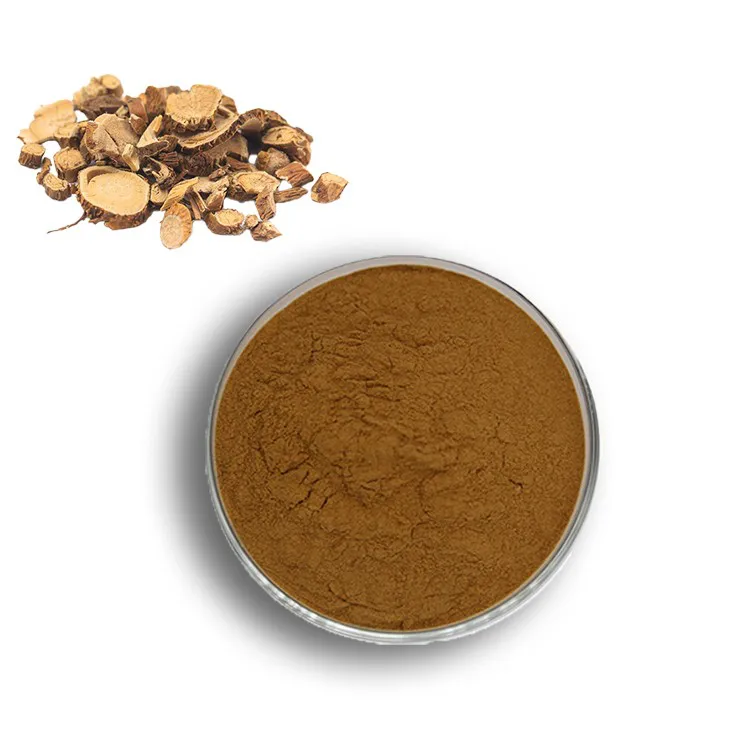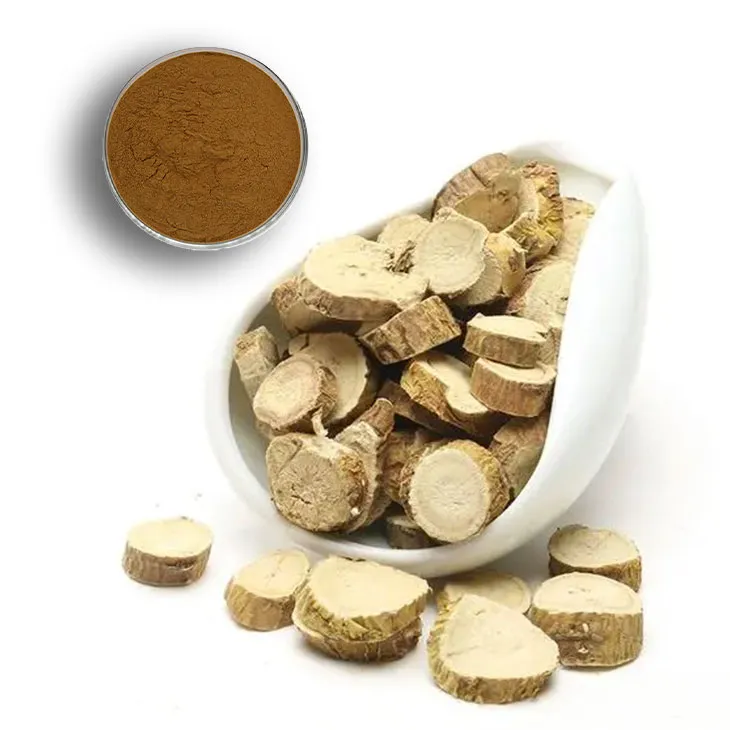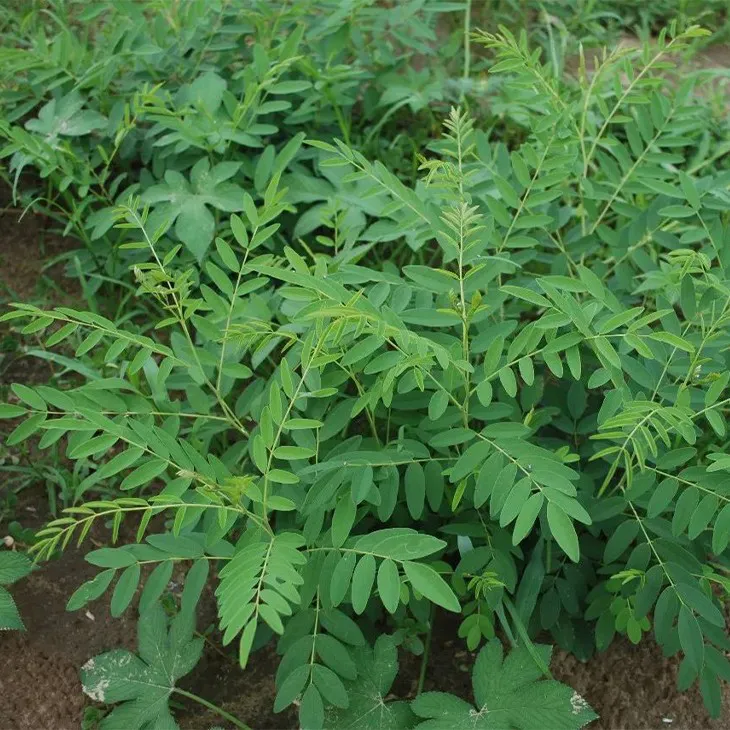- 0086-571-85302990
- sales@greenskybio.com
How to make powder from sophora flavescens root extract?
2024-11-28

1. Introduction
Sophora flavescens root has been widely used in traditional medicine for its various pharmacological properties. Extracting and converting it into powder form can enhance its usability, preservation, and ease of formulation in different applications. This comprehensive guide will take you through the entire process from the selection of raw materials to the final formation of the powder.

2. Raw Material Selection
Quality of Sophora Flavescens Root
- The first step in making high - quality Sophora Flavescens Root Extract powder is to select the right raw material. The root should be sourced from reliable suppliers. It is important to ensure that the sophora flavescens root is of a suitable variety. Different varieties may have slightly different chemical compositions and thus affect the quality of the extract.
- The root should be fresh and free from mold, rot, or other signs of deterioration. Old or damaged roots may contain lower levels of active ingredients or may be contaminated with harmful substances.
- When sourcing sophora flavescens root, it is advisable to choose those that are organically grown. Organic roots are less likely to be contaminated with pesticides, heavy metals, or other chemical residues, which can be transferred to the extract and final powder.
- Consider the geographical origin of the root. Roots grown in certain regions may have better quality due to favorable soil, climate, and cultivation practices. For example, some regions may have soil rich in specific minerals that can enhance the growth and active ingredient content of sophora flavescens root.

3. Extraction Process
Pre - treatment of the Root
- Once the suitable sophora flavescens root is selected, it needs to be pre - treated before extraction. The root should be washed thoroughly to remove dirt, debris, and any surface contaminants. This can be done by gently rinsing the root under running water until the water runs clear.
- After washing, the root may need to be dried partially. This helps in reducing the moisture content, which can affect the extraction efficiency. The root can be air - dried in a well - ventilated area or using a low - temperature drying device to avoid over - drying and loss of active ingredients.
- The choice of solvent is crucial in the extraction process. Common solvents used for sophora flavescens root extraction include ethanol, water, or a combination of both. Ethanol is often preferred as it can effectively extract a wide range of active ingredients such as alkaloids from the root.
- If water is used as a solvent, it should be of high quality, preferably purified or distilled water. However, water - only extraction may not be as efficient in extracting all the desired components as compared to ethanol - based extraction.
- A combination of ethanol and water, for example, in a certain ratio (such as 70:30 ethanol - to - water ratio), can sometimes provide a more comprehensive extraction, targeting different solubility characteristics of the active ingredients in the root.
- One common extraction method is maceration. In this method, the pre - treated sophora flavescens root is immersed in the selected solvent (e.g., ethanol or the ethanol - water mixture) in a sealed container for a certain period. This period can range from a few days to several weeks, depending on factors such as the size of the root pieces, the type of solvent, and the desired extraction efficiency.
- Another method is Soxhlet extraction. This is a more continuous extraction method where the solvent is continuously recycled through the root material. Soxhlet extraction can be more efficient in terms of time and solvent usage, but it requires specialized equipment.
- After the extraction period, the resulting solution contains the Sophora Flavescens Root Extract along with the solvent. This solution needs to be separated from the remaining solid root material. Filtration is a common method to achieve this separation. A filter paper or a fine - mesh filter can be used to obtain a clear extract solution.

4. Concentration of the Extract
Evaporation of Solvent
- Once the extract is obtained, the next step is to concentrate it by evaporating the solvent. This can be done using a rotary evaporator, which is a commonly used laboratory equipment for solvent evaporation. The rotary evaporator operates under reduced pressure, which allows the solvent to be evaporated at a lower temperature, thus minimizing the potential damage to the active ingredients in the extract.
- If a rotary evaporator is not available, simple evaporation under gentle heat can also be carried out. However, this method requires more careful monitoring to avoid over - heating. The extract should be stirred constantly during evaporation to ensure uniform concentration.
- It is important to monitor the concentration of the extract during the evaporation process. This can be done by measuring the volume of the extract at regular intervals. As the solvent evaporates, the volume of the extract will decrease, and the concentration of the active ingredients will increase.
- Another method to monitor the concentration is by using analytical techniques such as spectrophotometry. Spectrophotometry can measure the absorbance of the extract at a specific wavelength, which can be correlated to the concentration of certain active ingredients.
5. Drying to Powder
Spray Drying
- Spray drying is a popular method for converting the concentrated Sophora Flavescens Root Extract into powder. In this method, the concentrated extract is sprayed into a hot drying chamber through a nozzle. The hot air in the chamber rapidly evaporates the remaining moisture in the extract, resulting in the formation of fine powder particles.
- The advantage of spray drying is that it can produce a powder with a relatively uniform particle size and good flowability. However, it requires specialized spray drying equipment, which can be expensive.
- Freeze - drying, also known as lyophilization, is another option. In this process, the concentrated extract is first frozen, and then the frozen water in the extract is removed by sublimation under reduced pressure. Freeze - drying can preserve the structure and activity of the active ingredients in the extract to a greater extent compared to other drying methods.
- However, freeze - drying is also a relatively slow process and requires specialized freeze - drying equipment, which is energy - intensive and costly.
- Vacuum drying is a more accessible method for some small - scale productions. In vacuum drying, the concentrated extract is placed in a vacuum chamber, and the moisture is removed under reduced pressure. This method can prevent oxidation of the active ingredients during drying due to the absence of oxygen in the vacuum environment.
- The drying time in vacuum drying may be longer compared to spray drying, but it is generally more affordable in terms of equipment cost.
6. Powder Characterization
Particle Size Analysis
- After obtaining the sophora flavescens root extract powder, it is important to analyze its particle size. Particle size can affect the solubility, bioavailability, and handling properties of the powder. Techniques such as laser diffraction can be used to measure the particle size distribution of the powder.
- A narrow particle size distribution may indicate a more uniform powder, which is often desirable for better formulation and quality control.
- Scanning electron microscopy (SEM) can be used to observe the morphology of the powder particles. The shape, surface texture, and porosity of the particles can provide insights into the drying process and the potential performance of the powder in different applications.
- For example, particles with a smooth surface may have different dissolution characteristics compared to those with a rough surface.
- To ensure the quality of the sophora flavescens root extract powder, chemical composition analysis is necessary. High - performance liquid chromatography (HPLC) can be used to analyze the content of specific active ingredients in the powder.
- Fourier - transform infrared spectroscopy (FTIR) can also be used to identify the functional groups present in the powder, which can provide information about the chemical structure and potential interactions of the active ingredients.
7. Storage and Packaging
Storage Conditions
- The sophora flavescens root extract powder should be stored in a cool, dry place. Exposure to high humidity can cause the powder to absorb moisture, which may lead to caking, deterioration, or degradation of the active ingredients.
- It is also advisable to store the powder away from direct sunlight, as ultraviolet light can cause chemical changes in the active ingredients.
- Appropriate packaging materials should be used to protect the powder during storage. For example, aluminum - foil - lined bags can provide a good barrier against moisture, oxygen, and light.
- Sealed glass containers can also be used, especially for long - term storage or for samples that need to be protected from environmental factors.
8. Conclusion
Making powder from sophora flavescens root extract involves multiple steps from raw material selection to final powder formation. Each step is crucial in ensuring the quality, safety, and effectiveness of the resulting powder. By following the proper procedures in extraction, concentration, drying, and subsequent analysis and storage, high - quality sophora flavescens root extract powder can be produced for various applications in traditional medicine, pharmaceuticals, or other related fields.
FAQ:
Question 1: What are the key factors in selecting sophora flavescens root for extraction?
The key factors in selecting sophora flavescens root for extraction include its origin, freshness, and quality. Roots from a clean and unpolluted environment are preferred. Freshly harvested roots usually contain more active ingredients. Also, the quality should be ensured, which means they should be free from diseases, pests, and excessive impurities.
Question 2: What extraction methods are commonly used for sophora flavescens root?
Common extraction methods for sophora flavescens root include solvent extraction. Ethanol is often used as a solvent. Another method is water extraction. These methods help to draw out the active components from the root. Maceration, percolation, and Soxhlet extraction are some of the techniques within these broader methods.
Question 3: How to ensure the purity of sophora flavescens root extract during the extraction process?
To ensure the purity of the extract during the extraction process, proper filtration is essential. Using high - quality filter materials can remove impurities such as plant debris. Also, careful control of extraction conditions like temperature, time, and solvent concentration helps to prevent the extraction of unwanted substances. Multiple extractions and purification steps may be carried out if necessary.
Question 4: What are the steps to convert the sophora flavescens root extract into powder?
First, the extract needs to be concentrated to reduce the solvent content. This can be done through evaporation under reduced pressure or other concentration methods. Then, drying techniques such as freeze - drying or spray - drying are used. Freeze - drying is good for maintaining the integrity of the active ingredients, while spray - drying is more efficient for large - scale production. After drying, the resulting solid can be ground into a fine powder.
Question 5: How to store sophora flavescens root extract powder properly?
To store sophora flavescens root extract powder properly, it should be kept in a cool, dry, and dark place. An airtight container is necessary to prevent moisture absorption and oxidation. It is also advisable to store it away from strong odors to avoid any potential contamination or interaction with other substances.
Related literature
- Studies on the Extraction and Properties of Sophora Flavescens Root Components"
- "Optimization of the Extraction Process of Sophora Flavescens Root and Its Application"
- "The Significance and Production of Sophora Flavescens Root Extract in Traditional Medicine"
- ▶ Hesperidin
- ▶ Citrus Bioflavonoids
- ▶ Plant Extract
- ▶ lycopene
- ▶ Diosmin
- ▶ Grape seed extract
- ▶ Sea buckthorn Juice Powder
- ▶ Fruit Juice Powder
- ▶ Hops Extract
- ▶ Artichoke Extract
- ▶ Mushroom extract
- ▶ Astaxanthin
- ▶ Green Tea Extract
- ▶ Curcumin
- ▶ Horse Chestnut Extract
- ▶ Other Product
- ▶ Boswellia Serrata Extract
- ▶ Resveratrol
- ▶ Marigold Extract
- ▶ Grape Leaf Extract
- ▶ New Product
- ▶ Aminolevulinic acid
- ▶ Cranberry Extract
- ▶ Red Yeast Rice
- ▶ Red Wine Extract
-
Eucommia Ulmoides Extract
2024-11-28
-
melatonin extract
2024-11-28
-
Bamboo Leaf extract
2024-11-28
-
Sugarcane Extract
2024-11-28
-
Black Garlic Extract
2024-11-28
-
Withania Somnifera Extract
2024-11-28
-
Red Date Extract
2024-11-28
-
Reishi mushroom extract
2024-11-28
-
Echinacea Extract
2024-11-28
-
Phyllanthus Emblica Extract
2024-11-28





















